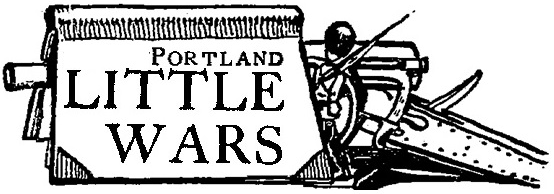The French were deployed with Swiss and landsknecht pikes in the center, each flanked by culverins, crossbowmen, and Scottish longbowmen. Behind the French left, three companies of Gendarmes lay in wait. Across from them, the Spanish lurked behind their earthworks, with a concentration of arquebusiers and culverins in the middle with pikes on the flanks. On the Spanish right were three companies of Ginettes and on the left two of Spanish men-at-arms.
(Above: starting positions)
(Above: Spaniards behind their earthwork)
(Above: Spaniards behind their earthwork)
Victory conditions were as follows: if you had more units than your opponent on the "platform" of the earthworks, you scored 3 points (2 earthwork sections, so 6 points maximum); if you drew a line out parallel from the "platform" to the table edge, and another one perpendicular from the outside end of the earthwork, you got a large "flank quarter" on each side, each worth 2 points; the entire area behind both earthworks was worth 2 points; also, for every enemy leader killed or routed, you received 1 point; and finally, the side that destroyed more units received a 3 point bonus. The game would stop when cumulative combined units lost by both sides totaled 10.

(Above: French Landsknechts move out from behind the Swiss)
The French decided to ignore history and not charge their Swiss right up the center, instead sending the Swiss, longbows, and Gendarmes left and the landsknechts and crossbows right. The Spanish attempted to run their Ginettes in front of their own earthworks in hoping of slicing up the French center to destroy guns and fall upon helpless archers. Instead they took too long and became pinned against the earthworks by aggressive Swiss pikes, who destroyed two of the three ginettes without much of a fight. The Spanish countered by sliding their mounted men-at-arms from their left to the right.
(Above: Spaniards behind their earthwork)
(Above: Spanish ginette light cavalry rides out)
(Above: Swiss pikes in French service advance)
(Above: Spanish ginette light cavalry about to get pinned by the Swiss)
(Above: the white skull counters are an experiment with tracking ammunition for the artillery - it had no effect on the game so will probably not try again)
The fiercest fighting then proceeded to unfold on the Spanish right, with the Swiss pikes getting the better of two Spanish pikes and the Gendarmes getting the best of the Spanish men-at-arms. But eventually the Spanish began to push back or rout some of the Swiss.
(Above: the Swiss push the Spanish back off the earthwork)
(Above: Spanish artillery at work!)
(Above: the Swiss have now been pushed back out of the earthwork by fierce Spanish counter attacks)
In the end the Spanish lost eight units (including one leader) and the French three (including two leaders!), so the French picked up the 3 point bonus for destroying more enemy units. However, they had only secured one flank and none of the earthwork platforms, so along with the one point for a killed enemy leader, their total score was only 6 points. The Spanish picked up 10 points (2 leaders destroyed at 1 point each, both earthwork sections at 3 points each, and the rear zone at another 2 points). The other flank zone had one Spanish and one French unit, so neither side received points for that.
(Above: that's a lot of casualties!)
(Above: end of game)
If this had used less complex victory conditions such as "first to lose half, they be the loser", this would have been a crushing defeat for the Spanish. Instead, on a points basis, it was a major victory. Retrospectively, it was decided the French should have concentrated all ranged attacks on a single unit if possible rather than along the Spanish line as a whole, and the Spanish should have utilized their light cavalry better. The Spanish should probably also have sallied a sword and buckler unit out of the earthworks to fall upon the melee-poor(er) archers and crossbowmen.
Next up: Isola della Scala and Ravenna at Enfilade!
*NOTE: I am slightly doubtful of the historicity of this scenario – there was a rather light siege of Barletta in the summer of 1502, but I can't find anything documenting the "bloody rout" of the Swiss mercenaries in French employ described by Sides. In fact, the Barletta scenario is so similar to the Cerignola (April 1503) scenario (itself a very well documented event) that I think the Barletta one is some sort of misunderstanding of the source material, and that Sides mistakenly inflated the events at Cerignola into two battles.


















No comments:
Post a Comment